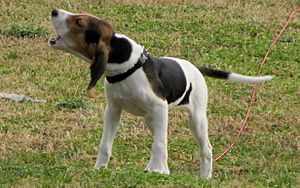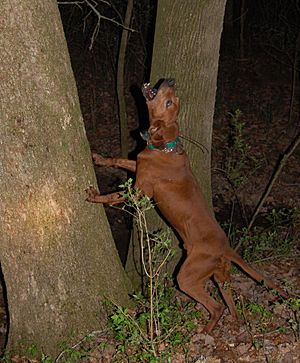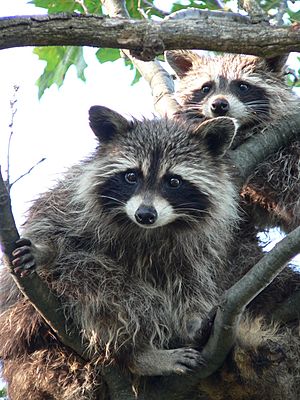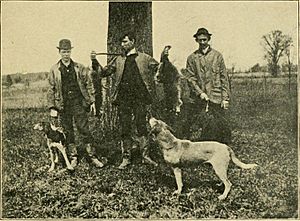Coon hunting facts for kids
Coon hunting or raccoon hunting is a type of hunting. People hunt raccoons, usually for their meat and fur. This sport often uses special dogs called coonhounds. There are six different breeds of these dogs.
Coon hunting is very popular in the countryside of the Southern United States and the Midwest. Most hunts happen at night. Dogs are let loose to find a raccoon's scent. They follow the scent until the raccoon climbs a tree. When the raccoon is in a tree and the dog is at the bottom, it's called "treed."
Besides hunting for meat or fur, there are also competitions. These events show how fast and skilled a dog is. In these competitions, raccoons are not killed. They are just treed and then let go. Some big competitions are the Grand American, Autumn Oaks, and Leafy Oaks. Coon hunting has been featured in books like Where the Red Fern Grows. It has also been part of stories and songs by artists like Jerry Clower and Jimmy Martin. In Alabama, there is even a special cemetery just for coon dogs.
Contents
Training Coonhounds
Coonhound puppies usually start learning to hunt when they are less than six months old. The dog's owner or trainer teaches them to follow the smell of a raccoon. They might use a raccoon's fur or a special scent stick.

After a young dog learns this, it goes hunting. It might hunt alone or with older, more experienced dogs. Many trainers like to have older dogs with younger ones. This way, the older dogs can show the younger ones what to do. Trainers say the hardest part is teaching the dog to ignore other animals. These include opossums, deer, and rabbits. Hunters often call these other animals "trash."
How Coon Hunting Works
Today, coon hunting mostly uses trained dogs. While any dog might have been used long ago, modern coon dogs are almost always coonhounds. There are six specific breeds of coonhounds. They were developed to hunt animals that climb trees by using their strong sense of smell. These breeds are the Black and Tan Coonhound, Redbone Coonhound, Bluetick Coonhound, English Coonhound, Treeing Walker Coonhound, and Plott Hound.
These breeds look a bit different in size, but their colors are the biggest difference. All but the Plott Hound come from the English Coonhound. Dogs can be "hot-nosed" or "cold-nosed." A hot-nosed dog will follow a fresh scent. A cold-nosed dog will follow an older scent. The Treeing Walker Coonhound is hot-nosed and very popular. Some hunters also use Louisiana Catahoula Leopard Dogs.

Hunters let their dogs go at night in places where raccoons live. These places might be forests, farm fields, or swamps. The dogs then find a raccoon's scent. Most dogs will make a long, loud bark when they find a trail. They will keep barking while they follow the raccoon. The dog's bark might change depending on how fresh the scent is. Coonhounds use only their sense of smell to find prey.
The hunt usually ends when the raccoon climbs a tree. When the dogs reach the tree, they stop their long barks. Instead, they start a short, sharp "tree" bark. This sound tells the hunter that a raccoon is in the tree. Some dogs can bark up to 150 times a minute when a raccoon is treed.
Hunters can either follow the dog as it hunts or wait in one spot. They only go to the dog once it has treed a raccoon. Special collars with GPS can help hunters find their dogs. In the past, hunters just listened for the dog's barks. Hunters often walk to the tree. Some use mules, horses, or all-terrain vehicles.
Hunters usually wear a headlight to keep their hands free. Old headlights used to be like those worn by coal miners. Today, there are special headlights for hunting. A .22 rifle is a common gun used. Strong boots are also important because of mud and rough ground.

Not all coon hunting happens in the wild. Many hunters enter their dogs in competition hunts, called nite hunts. In 2002, the United Kennel Club (UKC) held over 6,000 such hunts in the United States. The biggest annual hunts are the Autumn Oaks, Leafy Oaks, and Coonhunting World Championship. These are all UKC events.
The Autumn Oaks hunt is in Richmond, Indiana. It brings together competitors from many states and Canada. Another big hunt is the Grand American Coon Hunt. It has been held in Orangeburg, South Carolina since 1965. This event also has a popular dog show and special events for kids. The UKC also holds hunts for specific dog breeds. Other dog clubs, like the American Kennel Club, also have coon hunting competitions.
Killing raccoons is allowed during hunting season, usually from September to February. However, some hunters just tree the raccoon and leave it unharmed. In competitions, harming the raccoon can lead to being disqualified. Hunting for sport without killing the raccoon is like catch-and-release fishing. This is legal all year.
Hunting Rules
Like all game animals in the United States, raccoon hunting has rules. These rules are set by wildlife officials in each state. So, hunting seasons and how many raccoons you can hunt (bag limits) can be different. For example, in Tennessee, the season starts in mid-September and ends in February. You can hunt one raccoon per hunter per day. In Kentucky, the season starts in October and ends in February, with no bag limit. Some states, like Iowa, require a license to train a coonhound. It is usually against the law to hunt deer with dogs in most states.
History of Coon Hunting
Native Americans were the first to hunt raccoons. They used the animals for both meat and fur. Later, British and European settlers in North America also started hunting them.
Native hunters did not use dogs. But white hunters used dogs from early times. George Washington is said to have owned some of the first coon hunting dogs. These were French hounds given to him by the Marquis de Lafayette. Most early coon dogs were Foxhounds from Europe or mixed breeds. These dogs often had trouble finding raccoons once they climbed trees. So, people started to breed dogs specifically for their "treeing" ability. This meant the dog could follow a scent to a tree and stay there until the hunter arrived.

Coonhounds became a distinct type of dog by the late 1800s. Around 1885, a raccoon pelt (fur) sold for about 25 cents. Before World War I, raccoons were very common. Sometimes they were even poisoned to protect crops.
In the 1920s, raccoon fur coats became very popular. This made the price of pelts go up. So, more people started hunting and trapping raccoons. During the Great Depression in the 1930s, many rural families were poor. Raccoons were hunted a lot then and became quite rare. Hunters sold the furs for money, and the meat provided food. In the 1940s and 1950s, people started conservation efforts. They taught hunters not to cut down trees where raccoons raised their young. Because of this, the raccoon population grew. Now, raccoons are considered a "least-concern species," meaning they are not endangered.
In the 1950s, staged nite hunts were created. By the 1970s, these hunts were very popular. Some events had over a thousand dogs. In the 1970s, the price of raccoon pelts went up again, to $25 to $30 each. Some people made all their money from coon hunting. It was possible to catch ten raccoons a night in good areas. By the late 1980s, this type of market hunting mostly stopped. It is thought that trapping caught more raccoons than hunting with dogs during the fur boom.
Coon hunting is sometimes linked to hunting opossums. This is because the same dogs were often used. Both animals climb trees and live in the same areas. However, opossums are not hunted much today. People say they are too easy to hunt and too greasy to eat.
Coon hunting is still popular in the rural South and Midwest. A 2014 newspaper article noted that some coon hunters are regular people. But some earn a lot of money. A top coonhound can even cost as much as $40,000.
Coon Hunting in Books and Songs
In 1947, Fred Gipson wrote Hound-Dog Man. This novel tells the story of two young boys on a coon hunt in 1905 Texas. It was made into a movie in 1959, but the movie was not as successful as the book.
In 1961, Wilson Rawls published Where the Red Fern Grows. This book is about a young coon hunter named Billy Colman. He lives in the Oklahoma Ozark Mountains with his Redbone Coonhounds, Old Dan and Little Ann. The book became very popular in schools. A movie was made in 1974 and again in 2003.
The comedian Jerry Clower released a record called "The Coon Hunt" in the early 1970s. It was a funny story about a coon hunt in Mississippi that went wrong. This story became very popular and helped start Clower's career. It sold over $1 million and became a platinum record.
Country and bluegrass musician Jimmy Martin loved coon hunting as a hobby. He wrote and recorded several songs about his coonhounds. Two of his songs, "Pete, the Best Coon Dog in the State of Tennessee" and "Run Pete Run," became bluegrass hits. These songs describe a dog named Pete. In one song, you can even hear the voice of Martin's coonhound.
Besides stories, there are also magazines about coon hunting. Two of these are Coonhound Bloodlines and Full Cry.
Other Interesting Facts
The Key Underwood Coon Dog Memorial Graveyard is a special cemetery in Colbert County, Alabama. Since the 1930s, it has been used only for burying coonhounds.
Images for kids



